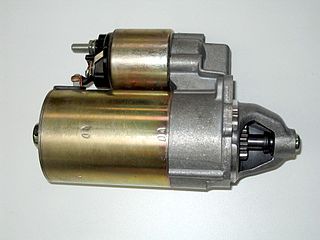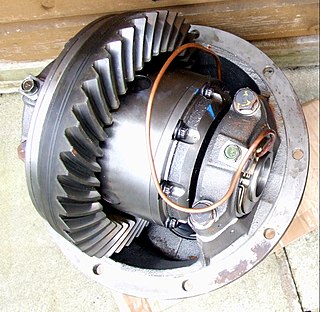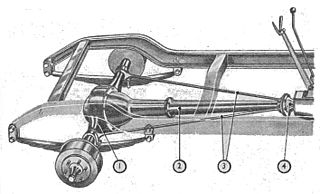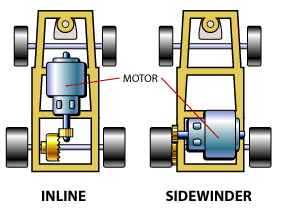
A starter is a device used to rotate (crank) an internal-combustion engine so as to initiate the engine's operation under its own power. Starters can be electric, pneumatic, or hydraulic. The starter can also be another internal-combustion engine in the case, for instance, of very large engines, or diesel engines in agricultural or excavation applications.

An axle or axletree is a central shaft for a rotating wheel or gear. On wheeled vehicles, the axle may be fixed to the wheels, rotating with them, or fixed to the vehicle, with the wheels rotating around the axle. In the former case, bearings or bushings are provided at the mounting points where the axle is supported. In the latter case, a bearing or bushing sits inside a central hole in the wheel to allow the wheel or gear to rotate around the axle. Sometimes, especially on bicycles, the latter type of axle is referred to as a spindle.

A Differential is a mechanical device that allows wheels to rotate at different speeds while receiving equal torque. It's crucial for motor vehicles to navigate corners smoothly, as the outer wheel travels a greater distance than the inner one. Without a differential, the vehicle's wheels could slip, or the drive axle could snap.

A four-wheel drive, also called 4×4 or 4WD, is a two-axled vehicle drivetrain capable of providing torque to all of its wheels simultaneously. It may be full-time or on-demand, and is typically linked via a transfer case providing an additional output drive shaft and, in many instances, additional gear ranges.

A limited-slip differential (LSD) is a type of differential gear train that allows its two output shafts to rotate at different speeds but limits the maximum difference between the two shafts. Limited-slip differentials are often known by the generic trademark Positraction, a brand name owned by General Motors and originally used for its Chevrolet branded vehicles.

A slot car or slotcar is a powered miniature automobile or other vehicle that is guided by a groove or slot in the track on which it runs. A pin or blade extends from the bottom of the car into the slot. Though some slot cars are used to model highway traffic on scenic layouts, the great majority are used in the competitive hobby of slot car racing or slot racing.

In automotive design, a front-engine, front-wheel-drive (FWD) layout, or FF layout, places both the internal combustion engine and driven roadwheels at the front of the vehicle.

A locking differential is a mechanical component, commonly used in vehicles, designed to overcome the chief limitation of a standard open differential by essentially "locking" both wheels on an axle together as if on a common shaft. This forces both wheels to turn in unison, regardless of the traction available to either wheel individually.

A drive shaft, driveshaft, driving shaft, tailshaft, propeller shaft, or Cardan shaft is a component for transmitting mechanical power, torque, and rotation, usually used to connect other components of a drivetrain that cannot be connected directly because of distance or the need to allow for relative movement between them.

A traction motor is an electric motor used for propulsion of a vehicle, such as locomotives, electric or hydrogen vehicles, or electric multiple unit trains.

An inboard brake is an automobile technology wherein the disc brakes are mounted on the chassis of the vehicle, rather than directly on the wheel hubs. Its main advantages are twofold: a reduction in the unsprung weight of the wheel hubs, as this no longer includes the brake discs and calipers; and braking torque is applied directly to the chassis, rather than being transferred to it through the suspension arms.

A torque tube system is a power transmission and braking technology that involves a stationary housing around the drive shaft, often used in automobiles with a front engine and rear drive. The torque tube consists of a large diameter stationary housing between the transmission and rear end that fully encloses a rotating tubular steel or small-diameter solid drive shaft that transmits the power of the engine to a regular or limited-slip differential. The purpose of a torque tube is to hold the rear end in place during acceleration and braking. Otherwise, the axle housing would suffer axle wrap, such that the front of the differential would lift up excessively during acceleration and sink down during braking. Its use is not as widespread in modern automobiles as is the Hotchkiss drive, which holds the rear end in place and prevents it from flipping up or down, during acceleration and braking, by anchoring the axle housings to the leaf springs using spring perches.

A jackshaft is an intermediate shaft used to transfer power from a powered shaft such as the output shaft of an engine or motor to driven shafts such as the drive axles of a locomotive. As applied to railroad locomotives in the 19th and 20th centuries, jackshafts were typically in line with the drive axles of locomotives and connected to them by side rods. In general, each drive axle on a locomotive is free to move about one inch (2.5 cm) vertically relative to the frame, with the locomotive weight carried on springs. This means that if the engine, motor or transmission is rigidly attached to the locomotive frame, it cannot be rigidly connected to the axle. This problem can be solved by mounting the jackshaft on unsprung bearings and using side-rods or chain drives.
The powertrain layout of a motorised vehicle such as a car is often defined by the location of the engine or motors and the drive wheels.

Anglewinder is a type of slot car or motorized model car in which the motor shaft runs at an angle to the driven axle and drives it through a bevel or other angled gear arrangement. It is a development of the sidewinder, or transverse motor, in which the motor shaft is parallel to the driven axle and power is transmitted through spur gears or a belt. The anglewinder arrangement allows use of a slightly longer motor than a pure sidewinder. It also moves the motor's weight forward in the car, which some racers believe improves handling.
The Tamiya TXT-1, which stands for Tamiya eXtreme Truck, was one of Tamiya's 1/10 scale radio controlled (RC) Monster Trucks.

The pancake motor, as used in slot cars, is a type of electric motor, which has a flat commutator and vertical shaft. It was a feature of the highly successful Aurora HO slot cars of the 1960s and 1970s. The motor was not a separate unit; instead, its individual elements - magnets, armature, commutator and brushes - fit into recesses in the blocky chassis. The power was carried by a chain of spur gears along the top of the chassis, to a pinion which drove a crown gear at the axle. Like most slot car motors, the Aurora pancakes ran on low voltage direct current.

In the model car hobby, an inline car is a type of slot car or other motorized model car in which the motor shaft runs lengthwise down the chassis, perpendicular to the driven axle. Power is transmitted through a pinion to a crown gear on the axle, or through bevel gears.

A drivetrain or Transmission System, is the group of components that deliver mechanical power from the prime mover to the driven components. In automotive engineering, the drivetrain is the components of a motor vehicle that deliver power to the drive wheels. This excludes the engine or motor that generates the power. In marine applications, the drive shaft will drive a propeller, thruster, or waterjet rather than a drive axle, while the actual engine might be similar to an automotive engine. Other machinery, equipment and vehicles may also use a drivetrain to deliver power from the engine(s) to the driven components.
This glossary of automotive terms is a list of definitions of terms and concepts related to automobiles, including their parts, operation, and manufacture, as well as automotive engineering, auto repair, and the automotive industry in general. For more specific terminology regarding the design and classification of various automobile styles, see Glossary of automotive design; for terms related to transportation by road, see Glossary of road transport terms; for competitive auto racing, see Glossary of motorsport terms.


















